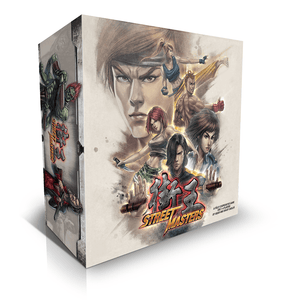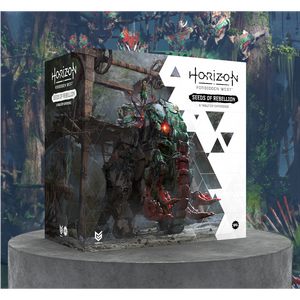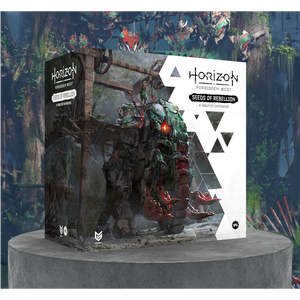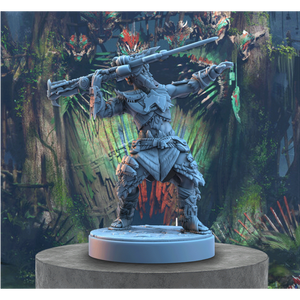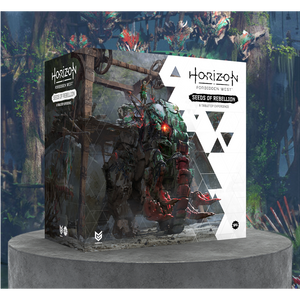Resident Evil: The Board Game is coming to Kickstarter on October 26, and we can’t wait for you to experience the spine-tingling horror for yourselves...
If you’ve played the Resident Evil 2 or 3 board games, you’ll already have an idea of the basic mechanics for this game. And if you’ve never played a Resident Evil board game in your life, but you’re thinking of dipping your toe into the tabletop world of survival horror, you’re in for a treat.
Why?
Because Resident Evil: The Board Game builds on the tried-and-tested survival horror engine of the previous two board games that kept players on the edge of their seats, all while introducing brand new mechanics (like puzzles!) and a stage-reveal map system to keep you on your toes.

So, whether you’re here to see what’s different or curious whether tabletop Resident Evil is right for you, welcome! Let’s see what Sherwin, Lead Designer, has to share...
(Confused about the order? In a nutshell, we released Resident Evil 2: The Board Game, followed by Resident Evil 3: The Board Game, and now we’re finally going back to the beginning for Resident Evil: The Board Game. More on that here.)
How to Play Resident Evil: The Board Game
by Sherwin Matthews, Lead Designer
If you’re new to Resident Evil board games, today’s post is for you. But don’t worry, veterans. I’ll do my best to entertain you, too!

With that in mind, before we get straight into the walkthrough, here’s a little insight into how we went about translating video gameplay into board game mechanics:
Designing the Gameplay
With each Resident Evil board game, we’ve iterated on the survival horror engine, fleshing it out and adding new mechanics to evolve your experience. Every time you delve into the tabletop world of Resident Evil, it needs to feel fresh but familiar — just as it does with each new video game release.
That all started with Resident Evil 2: The Board Game.
When Mat and I (Mat Hart, Creative Director and co-founder) first sat down to design that game, we began as we always do with licensed games: We identified the key pillars that make the video game experience what it is.
For us, it’s vital that any tabletop game feels as close to the source material as possible — whether that’s directly translating mechanics, or trying to capture and evoke the same player emotions in a way that makes sense on the tabletop.
So, what are these key pillars? What makes Resident Evil’s unique brand of survival horror so compelling? Once we’d identified those, we could start building our game’s core engine.
From our big whiteboard of scribbled notes, several jumped out.
Resource management, rising tension, jump scares, atmospheric environments, narrative, isolation, strategic depth of movement.
So, let’s walk through how to play a turn in Resident Evil: The Board Game, to see how those pillars are realised on the tabletop...
Player Turns
Stepping into the boots of your chosen S.T.A.R.S. character and heading into the mysterious Spencer Mansion, your exploration of that sinister place will be divided into turns.
When you end your turn, the next player will have their turn, and so on. Soon, you’ll find yourselves spread out across the mansion, perhaps too far to call for help… but let’s not get ahead of ourselves.
If gameplay is divided into player turns, how do the enemies get a turn?
Well, in Resident Evil board games, enemies don’t take their own turns. Instead, not unlike a turn-based strategy computer game, enemies will react as part of your turn. We’ll cover that in more detail in the reaction phase, below.
Because enemy turns and maintenance steps are covered as part of each player’s turn, the game is fast-paced and the core mechanics are fairly quick to get to grips with — leaving your mind free to figure out how best to survive the night.
You’ll need to figure that out together, because Resident Evil: The Board Game is a cooperative game. If one of you dies, you all fail. So, expect to be talking with your fellow S.T.A.R.S. about which way to turn next. (And remember this later on.)
Action Phase
Your turn will have three phases: action, reaction, and tension.
In the action phase, you can move, attack, interact with items, explore new rooms, open or close doors and, if you’re in a tough spot, even try to evade enemies.
You can only take four actions in a turn, but none of those are limited. So, if you wanted to walk four times, attack four times or, for some reason, open and close a door repeatedly, you could.

Think of it this way: Anything you’d need to press a button on your console’s controller to do is an action.
Now, if all this sounds pretty straightforward so far, it’s because we’ve deliberately kept the rules as user-friendly and intuitive as possible. But don’t let that fool you.
Each time you attack, you use up precious ammunition. Each time you heal, you use up an item in your inventory.
Everything you do should be viewed through a lens of resource management. Even your health is a resource. Do you risk getting attacked later to conserve ammo now, or are you already dangerously close to death?
And speaking of inventories, your character can only carry a limited number of items. That means they need to either store items in item boxes, or trade with other players before going out foraging.
Once you’ve performed your four actions (or skipped actions, if you like to live dangerously), it’s time for the reaction phase.
Reaction Phase
As above, enemies don’t have their own turn. Instead, they move and attack during player turns, as if alerted by whatever your character did during the action phase.
This works in two ways:
1. They Can Hear You...
Once you’ve used up your four actions, any enemies on the same tile or a tile connected to your character’s tile by an open door will react.
(Essentially, that’s any enemy that would be able to see or hear your character.)
If those enemies are in range to attack, they’ll attack. If not, they’ll move towards the closest character instead.
Side note: If you’ve got a spare action, never a bad idea to close the door behind you to avoid activating enemies that are close to your fellow S.T.A.R.S....
There are some extra subtleties to this system, such as special attacks, but we’ll cover those in the monster design article.
So, that’s the first way in which enemies react. But, that’s not the only way. Remember I said even moving can be fraught with danger? Well, read on…
2. Look Out!

Sometimes, the actions you take will trigger an out-of-sequence enemy reaction.
(Out-of-sequence reactions are when an enemy performs a reaction during a player’s action phase.)
There are a few different ways this can happen, but here’s a good example:
If you find yourself in the same square as an enemy — whether they’ve moved toward you in a previous turn, or you’ve stepped in voluntarily — you’ll need to perform an evade roll to get past them.
What? You didn’t expect to just stroll past a zombie, did you?
That’s because the enemy will try to attack you as you pass through. If they manage to get you, they’ll stop you in your tracks. Your character won’t just be wearing fresh bite marks, but they’ll also either have to try to dodge again or find a new way past.
Another example is making attacks, which makes a lot of noise and attracts attention, meaning every enemy in earshot moves towards the character.
As you can probably tell, Resident Evil: The Board Game has a constantly evolving game state that requires you to think on your feet. Every turn is about looking at the board and deciding which resource is more valuable to you — your health and recovery items, or your ammunition, as you work out how to overcome the odds.
If you’d rather save your ammunition (and of course, in true survival horror fashion, you’ll run out of ammo a long while before you run out of enemies…), you’ll need to carefully position enemies by lining up runs past them.
If you decide you need to blast away instead, make sure you don’t get trapped in a corner…
Which brings us nicely to the final phase of a player turn.
Tension Phase
So, if you’re thinking we’ve recreated fast paced action and resource management, but are wondering where the atmosphere is, look no further.
In the tension phase, the player draws and resolves a card from the tension deck. Sounds simple, right?

The tension deck serves several functions. For one, it’s a timer. If the tension deck runs out, the game ends in failure, ensuring there’s pressure to keep you exploring and moving forward. The tension deck supports this with a healthy injection of flavour text, to keep you immersed in what’s happening to your poor characters. But that’s not all.
Mechanically, the tension deck introduces new rules and events that you’ll have to deal with during the coming turns, representing the strange and oftentimes lethal events of the video game.
A thud from the next room might put your character on edge, and make them not want to leave their current tile. Another card might suggest corpses are especially sinister in the low light, and apply additional modifiers to the characters creeping around them.
And of course, we have classic favourites — did anyone just hear a window break?
Tension cards change the game state to keep you guessing at what will happen next, and immerse you in the fight for survival.
There are even a few cards that break the fourth wall, including one that cautions you to keep quiet when discussing your plans, in case enemies hear...

So, Are You Ready to Step Inside the Mansion?
Thanks, Sherwin!
That’s been your overview of how to play Resident Evil: The Board Game, but stay tuned. We’ve got new mechanics to explore and bosses to encounter in future articles coming very soon.
If you’re new to tabletop survival horror, welcome — you’re in good company! There’s already a thriving Resident Evil tabletop community, which you can join right here.
Go ahead and introduce yourself in the comments. We won’t bite. (But the zombies might…)
And if you’re not following the Kickstarter yet, do that now so you don't miss the launch!
To follow the campaign, go to Kickstarter and hit 'Notify me on launch'.
Not long to go now, Survivors...

 Join us on Discord
Join us on Discord


